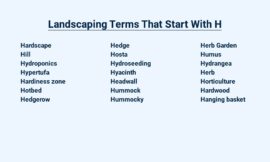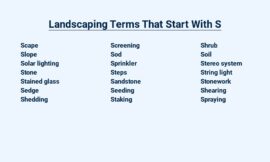Discover a comprehensive guide to landscaping terms that begin with the letter “L”.
From landscape architecture and lighting to mulching, maintenance, and leveling, I’ll provide clear explanations and insights to enhance your gardening knowledge and help you create a beautiful outdoor space.
| Term | Description |
| Landscape Architecture | The art and science of designing and planning outdoor spaces to achieve aesthetic, functional, and environmental goals. |
| Landscape Design | The process of creating a plan for the layout and appearance of a landscape, typically including elements such as plants, hardscaping, and water features. |
| Landscape Gardening | The art and practice of cultivating and maintaining plants in a landscape setting, typically for aesthetic or functional purposes. |
| Landscape Maintenance | The ongoing care and upkeep of a landscape, including tasks such as mowing, pruning, weeding, and fertilizing. |
| Landscape Lighting | The use of artificial lighting to enhance the appearance and safety of a landscape, typically at night. |
| Landscaping | The general term for the process of designing, installing, and maintaining landscapes. |
| Landscape Supply Store | A retail store that sells materials and supplies for landscaping projects, such as plants, soil, mulch, and hardscaping materials. |
| Lawn Care | The care and maintenance of a lawn, typically including tasks such as mowing, watering, and fertilizing. |
| Lawn Sprinkler System | A system of pipes and sprinklers used to automatically water a lawn. |
| Leach Field | A subsurface wastewater disposal system that uses natural soil processes to treat and disperse wastewater from a septic tank. |
Lantana: A genus of flowering plants native to the Americas, often used in landscaping for its colorful flowers and adaptability to various climates.
Lapacho: A genus of South American trees known for their beautiful flowers and durable wood, sometimes used in landscaping as ornamental trees.
Laurel: A genus of evergreen shrubs and trees, commonly used for hedging, privacy screens, and topiary.
Lavender: A genus of flowering plants known for their fragrant purple flowers, often used in landscaping for its ornamental value and its use in aromatherapy.
Lawn: A well-maintained area of short grass, typically found in residential and commercial properties, used for recreational purposes and aesthetic enhancement.
Layering: A landscaping technique involving the arrangement of plants at different levels to create depth and visual interest in a garden or landscape.
Leaf Blower: A device used to remove leaves and debris from lawns, driveways, and other outdoor surfaces.
Leaf Mulch: A layer of dead leaves used as a natural mulch around plants to retain moisture, suppress weeds, and improve soil fertility.
Leveling: The process of smoothing and grading a surface to achieve a uniform elevation, often done to prepare a site for construction or to improve drainage.
Ligustrum: A genus of shrubs and small trees, commonly used for hedges, topiary, and privacy screens.
Limestone: A type of sedimentary rock composed mainly of calcium carbonate, often used in landscaping as a decorative rock, for retaining walls, or as a soil amendment to raise the pH level.
Lily: A genus of flowering plants known for their large, showy flowers, often used in landscaping for their ornamental value and fragrance.
Lily Pond: A water feature in a garden or landscape designed to accommodate lilies and other aquatic plants, providing a tranquil and visually appealing element.
Lighting Design: The art of planning and installing outdoor lighting fixtures to enhance the aesthetic appeal and functionality of a landscape, often used to create ambiance, highlight architectural features, or improve safety.
Loam: A type of soil composed of a balanced mixture of sand, silt, and clay, considered ideal for plant growth due to its good drainage and water-holding capacity.
Lot Grading: The process of shaping and contouring a piece of land to achieve a desired slope or elevation, often done to ensure proper drainage, improve accessibility, or prepare a site for construction.
Landscaping Terms Starting with L
Landscape Architecture
Landscape architecture, a blend of art and science, transforms outdoor spaces into functional and aesthetically pleasing environments.
It encompasses the design, planning, and management of landscapes, considering factors like sustainability, ecology, and human interaction.
Landscape Fabric
Landscape fabric is a synthetic material used in landscaping to suppress weed growth and maintain soil moisture.
It is typically made from woven or non-woven polypropylene or polyester and is available in different weights and sizes.
Landscape fabric helps to create a barrier between the soil and the sun, preventing weed seeds from germinating and reducing water evaporation.
Landscape Lighting
Landscape lighting enhances the beauty and safety of outdoor spaces. It illuminates pathways, highlights architectural features, and creates a welcoming ambiance.
Proper lighting design considers factors like placement, fixture type, and energy efficiency to achieve the desired effect.
Landscape Maintenance
Landscape maintenance involves preserving, enhancing, and restoring the appearance, health, and safety of outdoor environments. It encompasses various tasks such as lawn mowing, pruning, weeding, irrigation, fertilization, pest control, and seasonal cleanup.
Effective maintenance ensures the longevity and beauty of a landscape while enhancing property value.
Landscape Mulch
Landscape mulch is a protective layer of organic or inorganic material applied to the surface of the soil.
It helps retain moisture, suppress weeds, moderate soil temperature, and enhance the overall appearance of the landscape.
Common mulch materials include bark, straw, leaves, compost, and rubber.
Landscape Plan
A well-crafted landscape plan enhances a property’s aesthetic appeal and functionality.
It incorporates thoughtful placement of plants, hardscaping elements, and design features to create a cohesive outdoor environment that meets the specific needs and preferences of the property owner.
Lawns
Lawns are areas of maintained grass, typically surrounding a home or other building.
They can be used for aesthetic purposes, recreation, or as a play area for children and pets.
Lawns require regular maintenance, including mowing, watering, and fertilizing, to keep them healthy and looking their best.
Leaves
Leaves are the primary photosynthetic organs of plants, responsible for producing food through sunlight, carbon dioxide, and water. Their shape, size, and color vary widely among species, serving as essential factors in plant identification and ecological adaptation.
Leveling
Leveling involves grading and smoothing the soil to create a flat and even surface.
This process is crucial in preparing the ground for various landscaping projects, such as laying patios, installing pools, and creating garden beds.
Proper leveling ensures proper drainage and prevents erosion.
Limestone
Limestone, a sedimentary rock composed mainly of calcium carbonate, finds wide application in landscaping.
Its versatility extends from retaining walls and patios to walkways and decorative features, owing to its durability, ease of shaping, and natural aesthetic appeal.
Lily Pond
A Lily Pond is a man-made or natural body of water designed to cultivate lilies and other aquatic plants. It adds aesthetic value to gardens and landscapes, providing a tranquil and serene atmosphere.
Lily ponds can be incorporated into various garden designs and serve as habitats for aquatic wildlife.
Lighting Design
Lighting Design: The art of arranging artificial lights to achieve a specific effect or mood in a landscape. It can accentuate features, create a sense of depth, and enhance safety and security.
Loam
Loam, a type of soil, holds a harmonious balance of sand, silt, and clay.
Its composition grants it exceptional drainage and moisture retention, making it a versatile and fertile choice for various gardening endeavors.
Lot Grading
Lot grading involves altering the land’s surface to achieve a desired slope or elevation.
This preparatory step ensures proper drainage, prevents erosion, and optimizes the site for construction or landscaping.
Final Verdict
In the realm of landscaping, a plethora of terms beginning with “L” hold significance.
From the meticulous planning of landscape architecture to the practical application of landscape fabric, lighting, maintenance, and mulch, each aspect contributes to the overall aesthetics and functionality of outdoor spaces.
Lawns, leaves, and leveling shape the foundation, while limestone, lily ponds, and lighting design add unique touches.
Loam and lot grading play crucial roles in soil quality and site preparation.
These terms, intertwined, reflect the depth and diversity of the landscaping profession.




